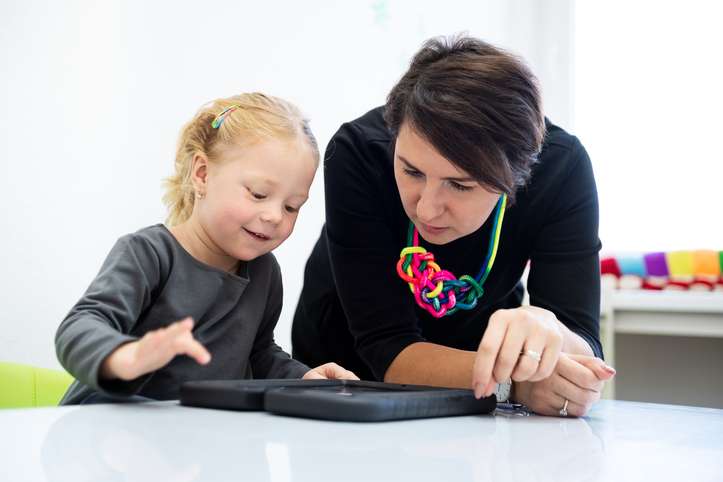Learning About Learning Disabilities and Special Needs in Children

What is the Legal Definition of Learning Disabilities?
The regulations for the Individuals with Disabilities Education Act (IDEA), define a learning disability as "a disorder in one or more of the basic psychological processes involved in understanding or in using language, spoken or written, which disorder may manifest itself in the imperfect ability to listen, think, speak, read, write, spell, or do mathematical calculations.”
Further qualifications for types of learning difficulties and intellectual disabilities includes, "such conditions as perceptual disabilities, brain injury, minimal brain dysfunction, dyslexia, and developmental aphasia.” Such term does not include “a learning problem that is primarily the result of visual, hearing, or motor disabilities, of intellectual disabilities, of emotional disturbance, or of environmental, cultural, or economic disadvantage.”
Having a single term to describe this category of children with disabilities reduces some of the confusion, but there are many conflicting theories about what causes learning disabilities and how many there are. The label "learning disabilities" is all-embracing; it describes a syndrome, not a specific child with specific problems. The definition assists in classifying children, not teaching them. Parents and teachers need to concentrate on the individual child. They need to observe how well the child performs, to assess strengths and weaknesses, and develop ways to help each child learn. It is important to remember that there is a high degree of interrelationship and overlapping among the areas of learning. Therefore, children with learning disabilities may exhibit a combination of characteristics.
These problems may mildly, moderately, or severely impair the learning process.
How many children have learning disabilities?
Many different estimates of the number of children with learning disabilities have appeared in the literature (ranging from 1 percent to 30 percent of the general population). According to the National Center for Learning Disabilities, 1 and 5 children have some kind of learning disability. These conditions include many issues such as dyslexia, ADHD, and other attention and mood regulation disorders. According to the NCLU, "Learning disabilities is the largest of the 13 disability categories covered under special education law. Currently, 39 percent of students receive special education for a learning disability.
What are the characteristics of a learning disability?
Learning disabilities are characterized by a significant difference in the child's achievement in some areas, as compared to his or her overall intelligence.
Students who have learning disabilities may exhibit a wide range of traits, including problems with reading comprehension, spoken language, writing, or reasoning ability. Hyperactivity, inattention, and perceptual coordination problems may also be associated with learning disabilities. Other traits that may be present include a variety of symptoms, such as uneven and unpredictable test performance, perceptual impairments, motor disorders, and behaviors such as impulsiveness, low tolerance for frustration, and problems in handling day-to-day social interactions situations. Learning disabilities may occur in the following academic areas:
- Spoken language: Delays, disorders, or discrepancies in listening and speaking;
- Written language: Difficulties with reading, writing, and spelling;
- Arithmetic: Difficulty in performing arithmetic functions or in comprehending basic concepts;
- Reasoning: Difficulty in organizing and integrating thoughts; and
- Organization skills: Difficulty in organizing all facets of learning.
What are the educational implications of a learning disability?
Since learning disabilities are manifested in a variety of behavior patterns, the Individual Education Program (IEP) must be designed carefully. A team approach is important for educating a child with a learning disability, beginning with the assessment process and continuing through the development of the IEP. Close collaboration among special class teachers, parents, resource room teachers, regular class teachers, and others will facilitate the overall development of a child with learning disabilities.
Some teachers report that the following strategies have been effective with some students who have learning disabilities:
- Capitalize on the student's strengths;
- Provide high structure and clear expectations;
- Use short sentences and a simple vocabulary;
- Provide opportunities for success in a supportive atmosphere to help build self-esteem;
- Allow flexibility in classroom procedures (e.g., allowing the use of tape recorders for note-taking and test-taking when students have trouble with written language);
- Make use of self-correcting materials, which provide immediate feedback without embarrassment;
- Use computers for drill and practice and teaching word processing;
- Provide positive reinforcement of appropriate social skills at school and home; and
- Recognize that students with learning disabilities can greatly benefit from the gift of time to grow and mature.
---
Reprinted from the National Information Center for Children and Youth with Disabilities (NICHCY).

